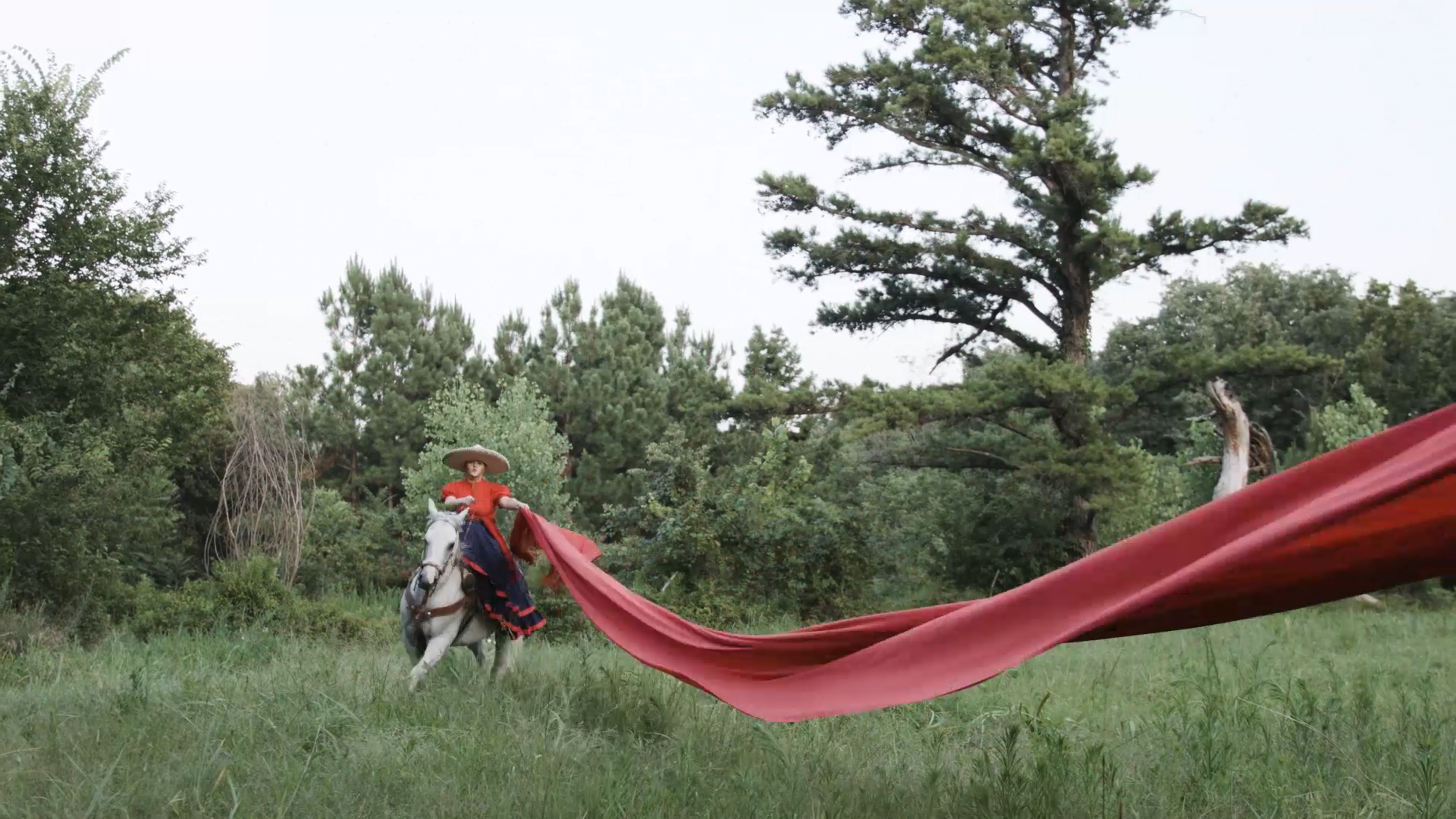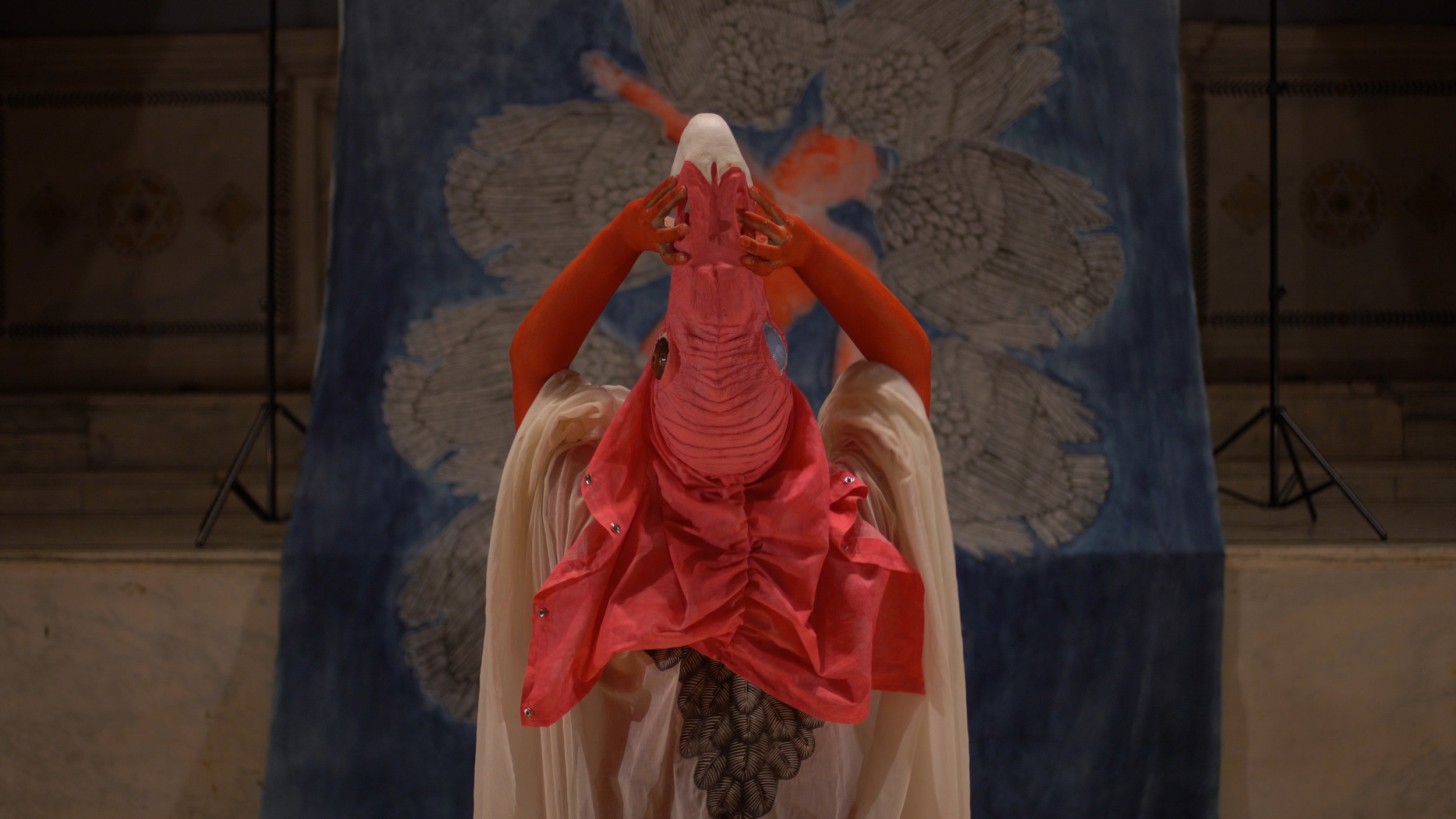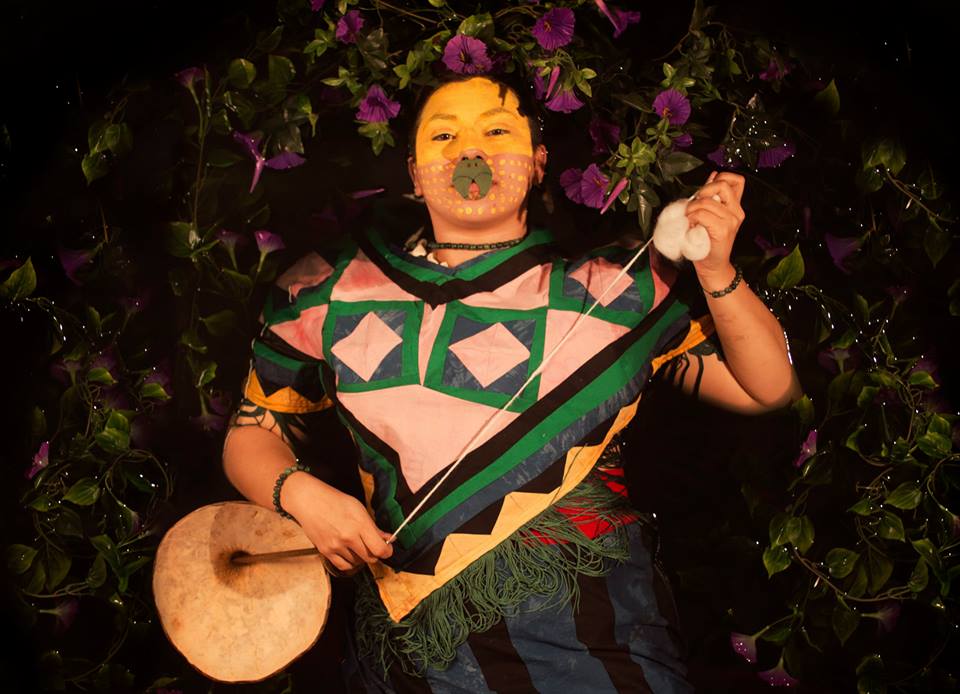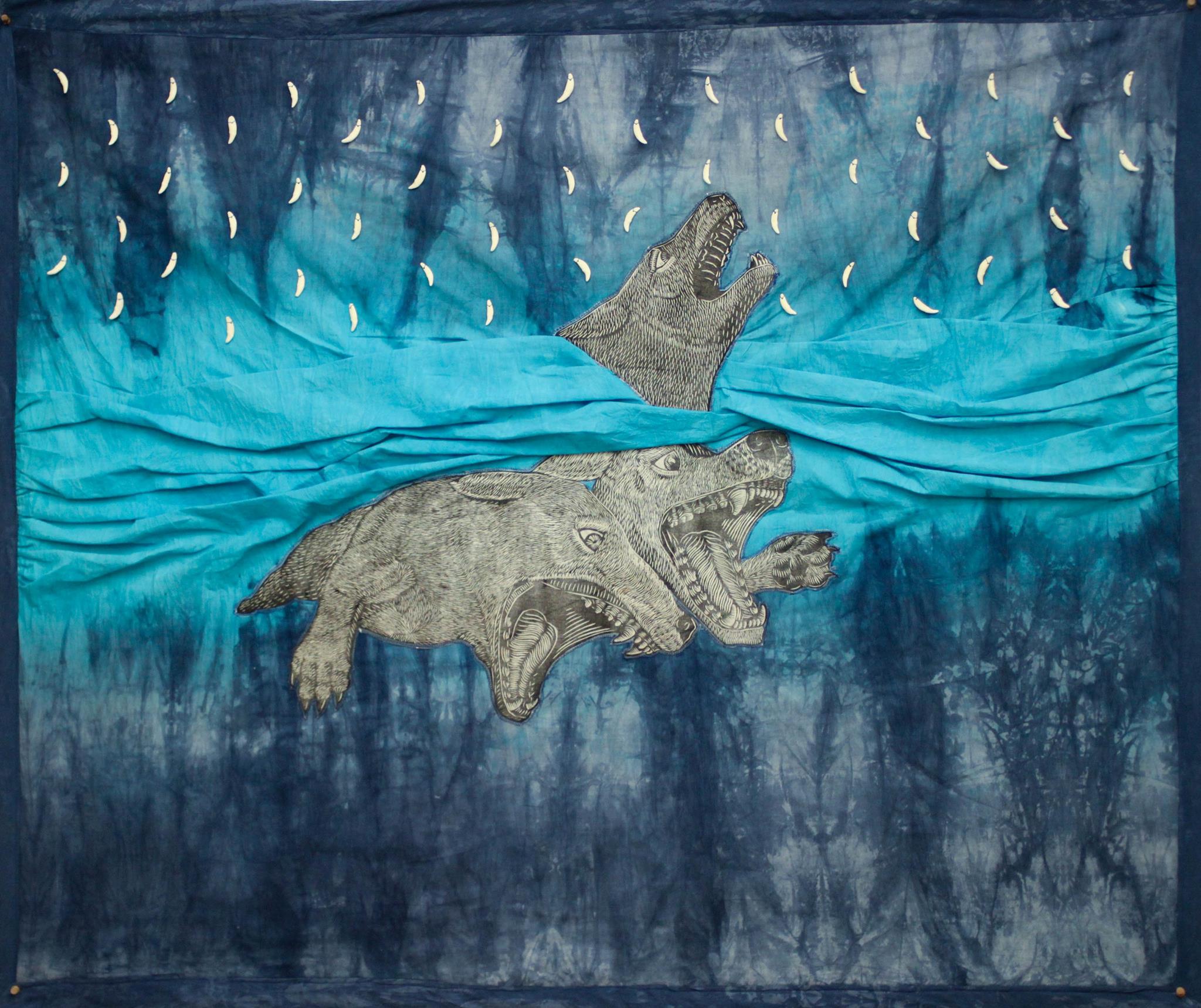
Tonantzin, "Our Mother" in Nahuatl.
In the Aztec language, nouns that define relationship include inalienable possession. This means a Mother always belongs to someone, or someone always belongs to them. Tonanztin is a title given to our Creatrixes" Coatlicue, Citlalicue, Chalchiutlicue, etc. These are all different representations of the life giving force of our Mother Earth.
In my ancestral prayer technologies the ones who dressed as the gods were called "Teixpitla" which roughly translates to "A Flayed Face" or a person who wears the flayed face of a god. This is important because it is not just a practice of embodying different forces in the world, but is rooted in the fundamental understanding that behind these masks is the same sacred energy animating them. Teotl, the Great Mystery, itself.
As I continue exploring haunting, syncretism, and visions in my work, I came back to the apparition of the Virgen de Guadalupe again. She appeared to Juan Diego as a young indigenous woman. She spoke Nahuatl to him. She was dressed in stars like Citlalicue, Skirt-Of-Stars, on Tepeyac, a hill that was once crowned with a temple to her, a snake at her feet. Not as a predator, but in its rightful place with its heart to the ground, signifying her cycles of life, death and rebirth.
The closer we stagger toward our destruction, toward apocalypse, through extraction, desecration and alienation of her, the more often people report having encounters with her and all her manifestations. Her message always clear: I will steward life into the next world as I always do, but life will be forever altered when I do it.
Piece completed during Material Transformations residency at Banff Centre for Arts and Creativity

In Cihuamichi, I act as La Llorona, a boogey man of Mexican folklore. Her story never felt right to me, a ghost made monstrous because of her grief for a future that will never be. Perhaps societal stigmas against sorrow are a kind of thalassophobia. Her narrative originated as the sixth omen that came to the Tenocha people heralding the conquest of the Americas. A woman's intuition is seen as crazed, though history would vindicate her. “My Children, Where will I hide my children?” the Florentine Codex says she keened in the streets at night implying the only place they would be safe from pestilence, rape, and slaughter was at the bottom of the lake, where she soon joined them. I see this as a solastalgic experience, or pre-traumatic stress. The moniker given to the indigenous peoples of the Americas, “savage,” gave way to the ethological term “savaging,” or maternal infanticide. My ancestors believed those who died by drowning went to Tlalocan, our most verdant and fertile paradise. In this way, we could interpret La Llorona’s actions as merciful.
Those destined for Tlalocan received a special preparation to their bodies, with seeds placed on their face, which was painted like Tlaloc. This is an exquisite gesture of the procreative nature of destruction. Germination and conception both require a dismembering before anything can take root. In the creation of life, things often increase as they are destroyed. This piece is about the sanctity of the wound and grief, circumstances that bring you to the precipice of other dimensions, that transform you. This piece captures the feeling of helplessness that arises from ensuing horror unfolding around you and within you. That creates leaks, breaches, and broken promises like the transgression of a ship taking water, like the transgression of a ship taking people. When Europeans came to the New World, they shipped their findings: plants, animals and people, back overseas in menageries for all to see. No solace or comfort is afforded to the dehumanized. Most did not survive the transatlantic crossing. Save for the seemingly unmaimable Axolotl salamander.
The Axolotl is a regenerative creature that exists forever in an embryonic state. It therefore cannot be debilitated, classified, or exercised dominion over. The conquerors memory becomes history and his ideology becomes reason. Axolotls, by their nature, do not console western sensibilities of order and modernity. When my ancestors fished this animal from Lake Texcoco, regrowing limbs, we thought it was immortal and therefore named it after Xolotl, death itself. Incorruptible little Saints. To this day there are folk beliefs of not entering lakes in Mexico while menstruating, lest an Axolotl swim into your vagina and live in your womb drinking your blood. The antidote? A “brave” man putting his penis inside of the host so the creature will bite it, and it can be extracted.
Melissa K. Nelson describes these stories as demonstrating an ethic of kinship where women act as a “contact zone” or the site of interaction between the human and more than human. This ichthyic, primordial creature entangles and hybridizes the woman’s body into something terrifying. Rebecca Solnit says “The permeable borders of the female are what make her threatening to ideas of containment, control, accountability. In her things merge, and from her things emerge." Perhaps Catharsis is a Moirai. Maybe healing is a synonym for dead reckoning. I don’t need saving. I can not be confined to your borders or your cages. “I will be out here like a piece of endless body” wrote Louise Eldritch. If I am going to be a savage, a sacrifice, a monster slain, a ghost, made present by my erasure, let something indestructible rise from me abundant and wholly new. So few of us ever receive reparations from those who have wronged us. Let me metabolize this pain into revenants who might obtain justice for me in whatever way they can scavenge.

This project began by exploring alternative histories of land, in this case specifically the Rio Grande river, and creating a map that doesn't define borders but rather restores memories of a place. 109 people died last year crossing, many descendants of those who thousands of years ago crossed heading South into Mexico. Last year a photograph went viral of Óscar Alberto Martínez Ramírez and his daughter Valeria's bodies on the banks of the river after they tragically drowned. I wanted to create something that discussed that time and that grief. For the piece I wrote a poem and had it translated into Nahuatl, which is what you hear me singing in the video. It translates to:
"How much time Great River
Since you heard the good song of the Rememberer-People?
I will sing to you Great River
The good song, long like you, may it remind you
Of the good burial song Great River
You who watches like you are our mother
Watching our breath slow Great River
Dancing in your arms as you embrace us
our eyes you cover
The Rememberer-People Great River
The Cold-Not-Fish of your water
We crossed once before Great River
Now forever here we watch. "
In the piece I am holding a private conversation and asking the Rio Grande if it remembers me, if it remembers us. I am performing a blood letting ritual, which in our prayer technologies, is a kind of blood transfusion to the more-than-human. The ribbon connect my wound to the water, further emphasizing the wound, grief, mourning, blood and kinship and history.
I am also wrapped in a rebozo shawl which has many traditional uses from baby wearing, protection from evil-spirits and burial shrouds.
I have been thinking a lot about who bears witness to suffering. If knowing is witnessing and if that is a kind of mercy. The piece is also about trusting the word of the wound. It feels like people very casually share photos and videos of black and brown people dying and I find myself asking for another kind of mercy in that regard. That knowing what happened and seeing the pain it caused in a community could be enough.
Eve Tuck said, when discussing ongoing genocide: “I am a future ghost. I am getting ready for my haunting” In this piece I am also giving a nod to Rebecca Belmore’s work “Fringe”. I like to think of it as being the moment between death and resurrection.
Poetry inspired by Aracelis Girmay and Patricia Smith
With thanks to:
Luca Joan Curleigàse - “Guy Economist”
Gabe Reyes - Video
Russel Daniels - Piercer





This piece is titled Teomama, which in Nahuatl means “God Carrier” it was the name given to our medicine men and women who carried the bones of Huitzilopochtli from Aztlan to Tenochtitlan, present day Mexico City.
A few of you might recognize this composition, it is the image on the Mexican flag, an image of a prophecy. The Teomamas carried the medicine bundles for 200 years down into Anahuac valley waiting for a sign and it was when they reached lake Texcoco they finally saw it. An eagle eating a snake on a prickly pear cactus, a union of sky and earth, so they knew it was safe to build their city here. And so they did, on the lake.
In this piece I act as the Teomama, carrying the female hawk on my back and I am Tenochtitlan, the land, my garment and hair disappear into the water and the light reflected on it. Melissa K. Nelson, an Anishinaabe cultural ecologist talks about the Native Woman’s body that in so many stories acts as a kind of meeting place, a contact zone, between the human and more-than-human life which establishes an ethic of kinship between my body, the water and the sky. My ancestors long understood the abject was a tool for accessing the sublime. In this piece Im the Cuauhxicalli, the offering stone, the one who holds the heart cut from the sacrificed. This is a hawk, eating a quail and it is a blood transfusion to the cosmos. This is not the nature we want to see. But the earth is hungry.
With thanks to Ashley Davis, Preston Lowe and Cheri of Baywings Falconry



















Tonantzin, "Our Mother" in Nahuatl.
In the Aztec language, nouns that define relationship include inalienable possession. This means a Mother always belongs to someone, or someone always belongs to them. Tonanztin is a title given to our Creatrixes" Coatlicue, Citlalicue, Chalchiutlicue, etc. These are all different representations of the life giving force of our Mother Earth.
In my ancestral prayer technologies the ones who dressed as the gods were called "Teixpitla" which roughly translates to "A Flayed Face" or a person who wears the flayed face of a god. This is important because it is not just a practice of embodying different forces in the world, but is rooted in the fundamental understanding that behind these masks is the same sacred energy animating them. Teotl, the Great Mystery, itself.
As I continue exploring haunting, syncretism, and visions in my work, I came back to the apparition of the Virgen de Guadalupe again. She appeared to Juan Diego as a young indigenous woman. She spoke Nahuatl to him. She was dressed in stars like Citlalicue, Skirt-Of-Stars, on Tepeyac, a hill that was once crowned with a temple to her, a snake at her feet. Not as a predator, but in its rightful place with its heart to the ground, signifying her cycles of life, death and rebirth.
The closer we stagger toward our destruction, toward apocalypse, through extraction, desecration and alienation of her, the more often people report having encounters with her and all her manifestations. Her message always clear: I will steward life into the next world as I always do, but life will be forever altered when I do it.
Piece completed during Material Transformations residency at Banff Centre for Arts and Creativity
In Cihuamichi, I act as La Llorona, a boogey man of Mexican folklore. Her story never felt right to me, a ghost made monstrous because of her grief for a future that will never be. Perhaps societal stigmas against sorrow are a kind of thalassophobia. Her narrative originated as the sixth omen that came to the Tenocha people heralding the conquest of the Americas. A woman's intuition is seen as crazed, though history would vindicate her. “My Children, Where will I hide my children?” the Florentine Codex says she keened in the streets at night implying the only place they would be safe from pestilence, rape, and slaughter was at the bottom of the lake, where she soon joined them. I see this as a solastalgic experience, or pre-traumatic stress. The moniker given to the indigenous peoples of the Americas, “savage,” gave way to the ethological term “savaging,” or maternal infanticide. My ancestors believed those who died by drowning went to Tlalocan, our most verdant and fertile paradise. In this way, we could interpret La Llorona’s actions as merciful.
Those destined for Tlalocan received a special preparation to their bodies, with seeds placed on their face, which was painted like Tlaloc. This is an exquisite gesture of the procreative nature of destruction. Germination and conception both require a dismembering before anything can take root. In the creation of life, things often increase as they are destroyed. This piece is about the sanctity of the wound and grief, circumstances that bring you to the precipice of other dimensions, that transform you. This piece captures the feeling of helplessness that arises from ensuing horror unfolding around you and within you. That creates leaks, breaches, and broken promises like the transgression of a ship taking water, like the transgression of a ship taking people. When Europeans came to the New World, they shipped their findings: plants, animals and people, back overseas in menageries for all to see. No solace or comfort is afforded to the dehumanized. Most did not survive the transatlantic crossing. Save for the seemingly unmaimable Axolotl salamander.
The Axolotl is a regenerative creature that exists forever in an embryonic state. It therefore cannot be debilitated, classified, or exercised dominion over. The conquerors memory becomes history and his ideology becomes reason. Axolotls, by their nature, do not console western sensibilities of order and modernity. When my ancestors fished this animal from Lake Texcoco, regrowing limbs, we thought it was immortal and therefore named it after Xolotl, death itself. Incorruptible little Saints. To this day there are folk beliefs of not entering lakes in Mexico while menstruating, lest an Axolotl swim into your vagina and live in your womb drinking your blood. The antidote? A “brave” man putting his penis inside of the host so the creature will bite it, and it can be extracted.
Melissa K. Nelson describes these stories as demonstrating an ethic of kinship where women act as a “contact zone” or the site of interaction between the human and more than human. This ichthyic, primordial creature entangles and hybridizes the woman’s body into something terrifying. Rebecca Solnit says “The permeable borders of the female are what make her threatening to ideas of containment, control, accountability. In her things merge, and from her things emerge." Perhaps Catharsis is a Moirai. Maybe healing is a synonym for dead reckoning. I don’t need saving. I can not be confined to your borders or your cages. “I will be out here like a piece of endless body” wrote Louise Eldritch. If I am going to be a savage, a sacrifice, a monster slain, a ghost, made present by my erasure, let something indestructible rise from me abundant and wholly new. So few of us ever receive reparations from those who have wronged us. Let me metabolize this pain into revenants who might obtain justice for me in whatever way they can scavenge.
This project began by exploring alternative histories of land, in this case specifically the Rio Grande river, and creating a map that doesn't define borders but rather restores memories of a place. 109 people died last year crossing, many descendants of those who thousands of years ago crossed heading South into Mexico. Last year a photograph went viral of Óscar Alberto Martínez Ramírez and his daughter Valeria's bodies on the banks of the river after they tragically drowned. I wanted to create something that discussed that time and that grief. For the piece I wrote a poem and had it translated into Nahuatl, which is what you hear me singing in the video. It translates to:
"How much time Great River
Since you heard the good song of the Rememberer-People?
I will sing to you Great River
The good song, long like you, may it remind you
Of the good burial song Great River
You who watches like you are our mother
Watching our breath slow Great River
Dancing in your arms as you embrace us
our eyes you cover
The Rememberer-People Great River
The Cold-Not-Fish of your water
We crossed once before Great River
Now forever here we watch. "
In the piece I am holding a private conversation and asking the Rio Grande if it remembers me, if it remembers us. I am performing a blood letting ritual, which in our prayer technologies, is a kind of blood transfusion to the more-than-human. The ribbon connect my wound to the water, further emphasizing the wound, grief, mourning, blood and kinship and history.
I am also wrapped in a rebozo shawl which has many traditional uses from baby wearing, protection from evil-spirits and burial shrouds.
I have been thinking a lot about who bears witness to suffering. If knowing is witnessing and if that is a kind of mercy. The piece is also about trusting the word of the wound. It feels like people very casually share photos and videos of black and brown people dying and I find myself asking for another kind of mercy in that regard. That knowing what happened and seeing the pain it caused in a community could be enough.
Eve Tuck said, when discussing ongoing genocide: “I am a future ghost. I am getting ready for my haunting” In this piece I am also giving a nod to Rebecca Belmore’s work “Fringe”. I like to think of it as being the moment between death and resurrection.
Poetry inspired by Aracelis Girmay and Patricia Smith
With thanks to:
Luca Joan Curleigàse - “Guy Economist”
Gabe Reyes - Video
Russel Daniels - Piercer
This piece is titled Teomama, which in Nahuatl means “God Carrier” it was the name given to our medicine men and women who carried the bones of Huitzilopochtli from Aztlan to Tenochtitlan, present day Mexico City.
A few of you might recognize this composition, it is the image on the Mexican flag, an image of a prophecy. The Teomamas carried the medicine bundles for 200 years down into Anahuac valley waiting for a sign and it was when they reached lake Texcoco they finally saw it. An eagle eating a snake on a prickly pear cactus, a union of sky and earth, so they knew it was safe to build their city here. And so they did, on the lake.
In this piece I act as the Teomama, carrying the female hawk on my back and I am Tenochtitlan, the land, my garment and hair disappear into the water and the light reflected on it. Melissa K. Nelson, an Anishinaabe cultural ecologist talks about the Native Woman’s body that in so many stories acts as a kind of meeting place, a contact zone, between the human and more-than-human life which establishes an ethic of kinship between my body, the water and the sky. My ancestors long understood the abject was a tool for accessing the sublime. In this piece Im the Cuauhxicalli, the offering stone, the one who holds the heart cut from the sacrificed. This is a hawk, eating a quail and it is a blood transfusion to the cosmos. This is not the nature we want to see. But the earth is hungry.
With thanks to Ashley Davis, Preston Lowe and Cheri of Baywings Falconry